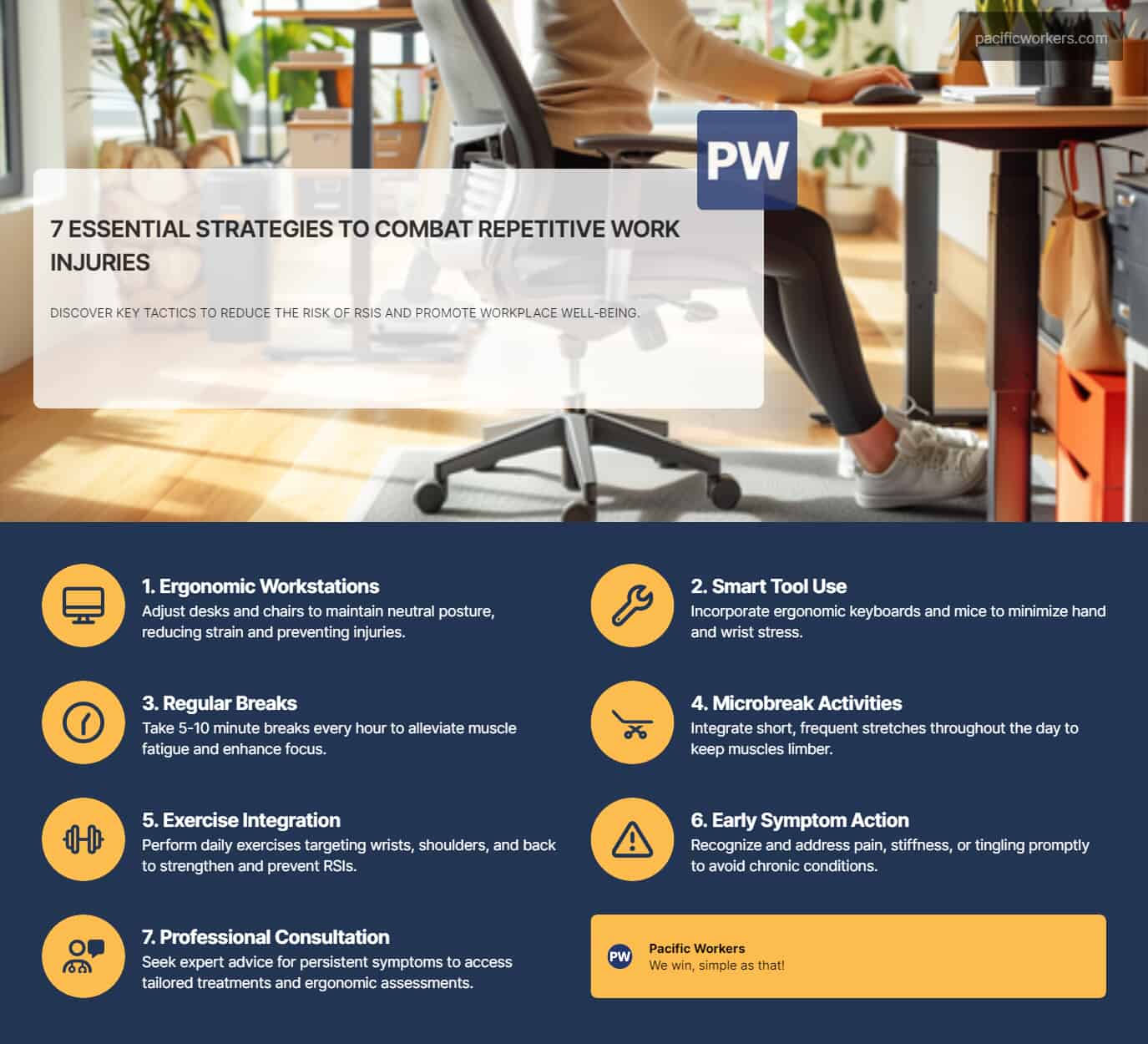Repetitive work injuries are a significant concern across various industries, affecting both employees' health and overall workplace productivity. These traumas, often resulting from tasks that involve the same motions or sustained awkward postures, can lead to chronic pain and long-term disability if not addressed properly. Ensuring that your workplace is set up to minimize these risks is crucial.
In this guide, we'll explore practical strategies to prevent frequent work complications, focusing on ergonomic practices, proper workplace setup, and the importance of regular breaks. We'll also cover specific exercises and stretches that can be seamlessly integrated into your daily routine to keep your body in top shape.
Whether you're an employee looking to safeguard your health or an employer aiming to create a safer work environment, these insights will help you take proactive measures to reduce the risk of a serious harm and promote overall well-being.
Ergonomic Practices to Prevent Repetitive Work Injuries
Workstation Setup
A well-designed workstation is crucial for preventing repetitive work injuries effects. Ergonomic furniture and equipment can significantly reduce strain on the body. Proper desk and chair height adjustments are essential to maintain a neutral posture. The desk should be at elbow height when seated, and the chair should support the lower back while allowing feet to rest flat on the floor.
Positioning of computer monitors and keyboards also plays a vital role. Monitors should be at eye level to avoid neck tension, and keyboards should be placed so that wrists remain straight while typing. These adjustments help in maintaining a natural alignment of the body, reducing the risk of tension-related complications.
Tools and Accessories
Using ergonomic tools can further enhance workplace safety. Ergonomic keyboards and mice are designed to minimize physical stress on the hands and wrists. Standing desks and anti-fatigue mats offer alternatives to prolonged sitting, promoting better posture and circulation. Wrist supports and footrests provide additional comfort and support, helping to prevent strain injuries.
Designing a Safe Workplace Environment

Layout and Organization
The layout and organization of the workplace can significantly impact the risk of repetitive work injuries. Workspaces should be arranged to minimize pressure, with frequently used items within easy reach. Adequate lighting and ventilation are also crucial, as poor lighting can lead to awkward postures and eye distress, while proper ventilation ensures a comfortable working environment.
Reducing clutter is another important aspect. A tidy workspace prevents unnecessary movements and allows for better focus and efficiency. Implementing these changes can create a more ergonomic and safe workplace.
Safety Protocols
Implementing safety guidelines and training is essential for preventing recurrence of strain injuries. Employees should be educated on the importance of ergonomic practices and encouraged to follow safety protocols. Management plays a crucial role in maintaining a safe environment by fostering a culture of safety and awareness. Regular safety audits and feedback sessions can help in identifying potential hazards and addressing them promptly.
Importance of Regular Breaks and Microbreaks
Scheduled Breaks
Taking regular breaks is vital for both physical and mental health. Scheduled breaks help in reducing muscle fatigue and improving concentration. It is recommended to take a 5-10 minute break every hour to stretch and move around. Effective break activities include walking, stretching, or simply stepping away from the workstation to relax.
Microbreaks to prevent Repetitive Work Injuries
Microbreaks, short breaks taken frequently throughout the day, can also be beneficial. These breaks involve simple exercises and stretches that can be performed at the workstation. Examples include wrist stretches, shoulder rolls, and neck stretches. Incorporating microbreaks into the daily routine helps in reducing muscle tension and preventing repeated strain injuries.
Exercises and Stretches to Prevent RSIs

Daily Exercise Routine
Incorporating physical activity into the workday is essential for preventing repetitive work injuries. Specific exercises can strengthen muscles and improve flexibility, reducing the risk of getting hurt. Exercises targeting common repetitive strain injuries (RSI) areas, such as wrists, shoulders, and back, should be included in the daily routine.
Examples of effective exercises include:
Wrist flexor and extensor stretches
Shoulder shrugs and rolls
Back extensions and stretches
Stretching Techniques
Effective stretching techniques can help in reducing muscle tension and preventing adverse effects. It is important to perform stretches correctly to avoid further strain. Stretching should be done slowly and gently, holding each stretch for 15–30 seconds. Incorporating stretching into the work routine can significantly reduce the risk of recurrence of tension-related ailments.
Monitoring and Addressing Early Signs of Injury
Recognizing Symptoms
Early detection and intervention are crucial in preventing repetitious joint traumas from becoming chronic. Common symptoms include pain, stiffness, and tingling in the affected areas. Self-assessment techniques, such as checking for tenderness or swelling, can help in identifying potential issues early on.
Seeking Professional Help
If symptoms persist, it is essential to consult a healthcare professional. Various treatments and therapies are available, including physical therapy, ergonomic assessments, and occupational health services. These interventions can help in managing symptoms and preventing further injury. Occupational health services play a vital role in accident prevention by providing expert guidance and support.
By following these guidelines, employees, and employers can work together to create a safer, more productive work environment, reducing the risk of repetitive work injuries and promoting overall well-being.
Conclusion: Wrapping Up the Fight Against Repetitive Work Injuries
Repetitive work injuries are a serious concern that can significantly impact both employees' health and workplace productivity. By understanding the nature of these discomforts and implementing ergonomic practices, we can create a safer work environment. Proper workstation setup, the use of ergonomic tools, and maintaining an organized workspace are essential steps in reducing the risk of frequent sprain incidents.
Regular breaks, microbreaks, and incorporating specific exercises and stretches into the daily routine are vital for maintaining physical health and preventing chronic pain. Early detection and professional intervention can make a significant difference in managing symptoms and avoiding long-term disability. By prioritizing these strategies, we can foster a healthier, more productive workplace.
Remember, a proactive approach today can prevent the pain of tomorrow—let's make our work environments places where well-being thrives.
About the author
 Bilal Kassem President and Co-founder
Bilal Kassem President and Co-founder
Introducing Bilal Kassem, the visionary leader of Pacific Workers. His unwavering commitment to excellence, empowering others at the core of our organization. With a flair for creativity, Bilal infuses fresh ideas into every initiative we take.
Drawing inspiration from captivating stories like “Goosebumps”, he guides our team with determination. Beyond his professional endeavors, Bilal embraces the great outdoors. As a result, relishing adventures such as backpacking and exploring uncharted territories. Sushi is his preferred treat, nourishing both his body and spirit.
In his free time, he enjoys hitting the gym and indulging in blockbuster films. Also, he finds motivation in the legacies of historical figures like George Patton. By leading with empathy, Bilal fosters a supportive atmosphere. This is why every team member feels empowered to excel.

